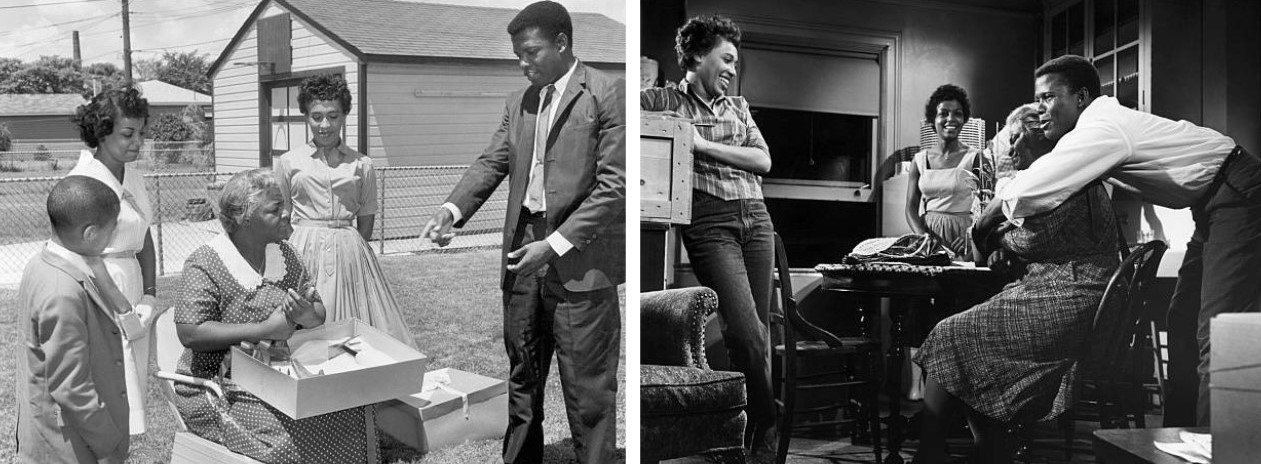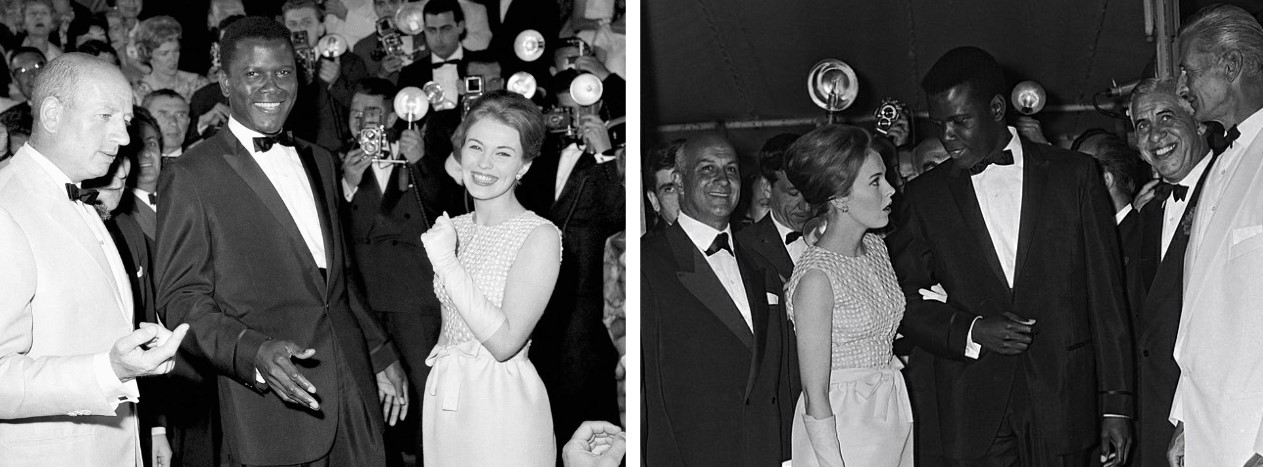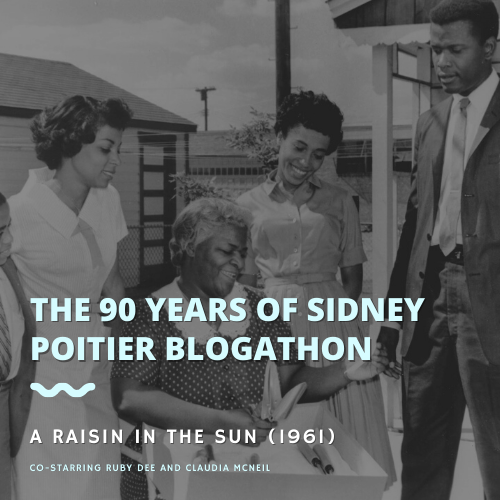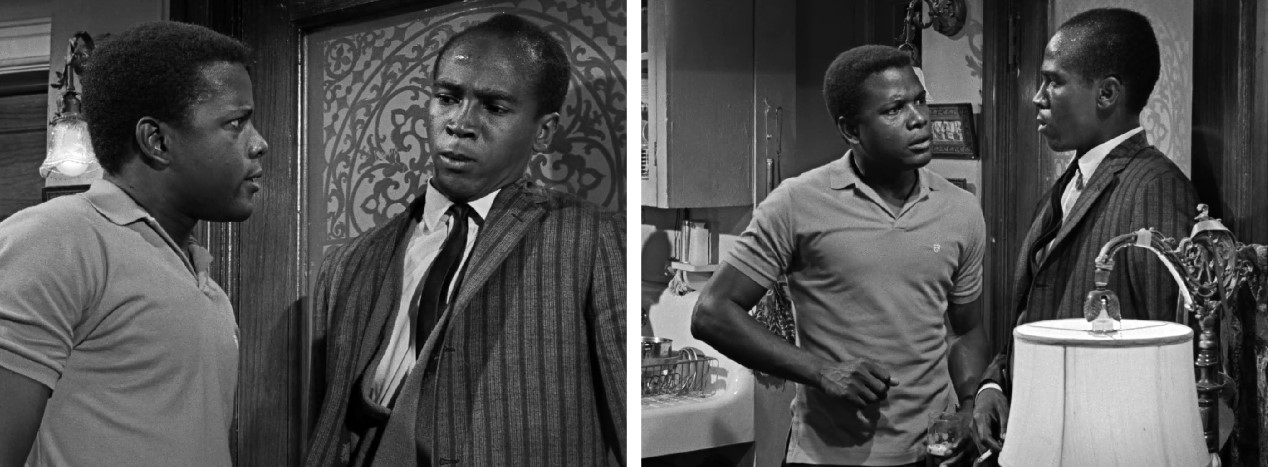Directed by Daniel Petrie, A Raisin in the Sun (1961) follows the Youngers, an impoverish Negro family whose routine is suddenly disrupted when Lena Younger (Claudia McNeil) receives a $10,000 check from the company that insured her late husband. Lena wants to use the money to buy a house and to help her daughter, Beneatha (Diana Sands), finish medical school. On the other hand, Lena's son, Walter Lee (Sidney Poitier), would rather use the money to invest in a liquor store, but his mother disapproves of the idea. Instead, she makes a down payment of $3,500 on a small house in a white neighborhood. Frustrated and enraged, Walter Lee quarrels with his mother and his wife, Ruth (Ruby Dee), and storms out of the flat.
 |
| LEFT: Stephen Perry, Ruby Dee, Claudia McNeil, Diana Sands and Sidney Poitier. RIGHT: Diana Sands, Ruby Dee, Claudia McNeil and Sidney Poitier. |
Three days later, Lena finds Walter Lee in a bar and offers him the remaining $6,500, telling him to save $3,000 of it to pay for Beneatha's education. Once more united and optimistic about their future, the Youngers prepare to move into their new home. Not even a visit from Karl Lindner (John Fielder), a hypocritical representative from the Clybourne Park Improvement Association who offers the family money in return for staying away and preserving the community's all-white character, can alter their decision to move.
Meanwhile, Walter Lee secretly invests the entire $6,500 in a liquor store and is swindled by one of his «partners», Willie Harris (Roy Glenn). Realizing that he has betrayed his mother's trust, threatened his sister's future and thrown away his father's life savings, Walter Lee desperately decides to accept Lindner's offer. When Lindner arrives, however, Walter Lee has a last-minute change of heart and rejects the offer once again. Although it means hard work and years of sacrifice for all, the Youngers make their move, believing that they can succeed through optimism, determination and remaining together as a family.
Walter Lee Younger: I'm a volcano, I'm a giant — and I am surrounded by ants! Ants who don't even know what I'm talking about!
Born into a well-to-do African-American family from the South Side of Chicago, Lorraine Hansberry grew up in a politically active household. The family was often visited by notable African-Americans, including musician Duke Ellington and Olympic gold medalist Jesse Owens, and the children were encouraged to engage in conversations on current topics.
After graduating from high school in 1948, Hansberry attended the University of Wisconsin in Madison, where she developed an interest in the plays of Irish dramatist Seán O'Casey and decided to pursue a career in the theater. Two years later, however, she left Madison and moved to New York to join the staff of Freedom, the radical publication produced by Paul Robeson, a prominent advocate of the Civil Rights Movements. In addition to working as a subscription clerk, receptionist, typist and and editorial assistant, Hansberry wrote news articles and editorials, which prompted her decision to dedicate herself to her playwriting on a full-time basis.
 |
| Lorraine Hansberry in her apartment at 337 Bleecker Street, New York City, in April 1959. |
Hansberry's first effort as a playwright was A Raisin in the Sun, which described the struggle of a lower-class black family from Chicago to gain middle-class acceptance. The title comes from the poem «Harlem» by Langston Hughes: «What happens to a dream deferred? / Does it dry up / Like a raisin in the sun? / Or fester like a sore? / And then run?»
Produced by Philip Rose and directed by Lloyd Richards, A Raisin in the Sun premiered at the Ethel Barrymore Theatre in New York on March 11, 1959. starred Sidney Poitier, Ruby Dee, Claudia McNeil, Diana Sands and Glynn Turman as the five members of the Younger family, with John Fiedler portraying the only white character in the story. Poitier recalled that opening night was «an electric night.» The three-act drama was a great popular and critical success, deemed by Frank Rich of The New York Times as a play that «changed American theatre forever.» Closing on June 25, 1960 after 530 performances, A Raisin in the Sun became the first play written by a black woman to be produced on Broadway, as well as the first with a black director.
 |
| Two scenes from the stage version of A Raisin in the Sun. |
Following the Broadway opening of A Raisin in the Sun, United Artists, Paramount, 20th Century Fox, Walter Mirisch, Hall Bartlett and Harry Belafonte all considered purchasing the screen rights to Hansberry's play. However, the author hesitated, fearing that Hollywood's «glossy little paws» would compromise her message. After friends convinced her that her story should reach a broader audience, Hansberry changed her mind and sold the property to David Susskind, who had just signed a production deal with Columbia Pictures.
A pioneer television talk-show host, Susskind was not afraid to tackle the most controversial topics of the day, such as race relations and the Cold War. As advertisers shied away from TV programs that attempted to make any kind of social statement, Susskind was convinced that film would offer him more creative freedom to do so. However, Columbia was initially reluctant to make A Raisin in the Sun, concerned that a virtually all-black cast would limit the film's commercial potential. Eventually, Susskind convinced that studio to move forward with the project, arguing that the play was «a warm, frequently amusing and profoundly moving story of Negro life in which, for once, the race issue is not paramount.»
 |
| LEFT: David Susskind in 1960, preparing to interview Vice-President Richard Nixon on television. RIGHT: Sidney Poitier and David Susskind on the set of A Raisin in the Sun. |
Insisting on writing the film script herself, Hansberry wanted to heighten the social aspects in the story by restoring some of the scenes and dialogue that had been cut from the original play and adding new ones. For instance, one sequence showed Lena Younger paying exorbitant prices at a South Side supermarket, and another depicted her white employer's patronizing disbelief when she quits her job. In another scene, Walter Lee faced similar condescension when a paternalistic liquor store owner discouraged him from starting his own business.
However, Columbia executives Sam Briskin and Arthur Kramer eliminated the new additions, warning that «the introduction of further race issue elements may lessen the sympathy of the audience, give an effect of propagandistic writing, and so weaken the story.» When Briskin provided suggestions on the screenplay, he removed dialogue with black slang, references to African-American culture and direct allusions to racism. He even took out a remark about French and British colonialism in Africa, for fear of offending European audiences.
When time came for casting, both Susskind and Philip Rose (who was a co-producer on the film at Hansberry's request) wanted Poitier to reprise his stage role as the troubled Walter Lee Younger, agreeing that he «should be an important box-office element.» Making his film debut in No Way Out (1950), Poitier quickly rose in popularity after playing an incorrigible high school student in Blackboard Jungle (1955). His acclaimed performance as an escaped chain gang convict in The Defiant Ones (1958) made him the first male actor of African descent to be nominated for a competitive Academy Award. With his star power on the rise, Poitier made sure to a sign a favorable deal to star in A Raisin in the Sun, after which most of the play's original cast (including Ruby Dee, Claudia McNeil and Diana Sands) joined the production.
Susskind and Rose planned to bring in Lloyd Richards to direct the film adaptation, as he was already familiar with the material, but Columbia vetoed his hiring. Briskin had investigated Richards's work at CBS television and learned that the director communicated well with actors, but needed help in the booth. Refusing to engage a technical novice to assist Richards, Briskin signed Canadian-born Daniel Petrie instead. A U.S. resident since 1945, Petrie began his career as a Broadway actor, making his debut that same year in the comedy Kiss Them For Me. In 1950, he moved to the new medium of television as a director for several of the most popular series of the time, such as The United States Steel Hour and Playhouse 90. A Raisin in the Sun was Petrie's second motion picture, having only directed The Bamble Brush (1960) before.
Susskind and Rose planned to bring in Lloyd Richards to direct the film adaptation, as he was already familiar with the material, but Columbia vetoed his hiring. Briskin had investigated Richards's work at CBS television and learned that the director communicated well with actors, but needed help in the booth. Refusing to engage a technical novice to assist Richards, Briskin signed Canadian-born Daniel Petrie instead. A U.S. resident since 1945, Petrie began his career as a Broadway actor, making his debut that same year in the comedy Kiss Them For Me. In 1950, he moved to the new medium of television as a director for several of the most popular series of the time, such as The United States Steel Hour and Playhouse 90. A Raisin in the Sun was Petrie's second motion picture, having only directed The Bamble Brush (1960) before.
In July 1960, A Raisin in the Sun began location shooting in Chicago, where the cast encountered racism in more places than those described in the script. For instance, the University of Chicago would not let Susskind use the school's name in the film and some white individuals reportedly disappeared from the streets when the cameras started rolling.
One of the few scenes shot on location was the Younger family's visit to the house on which Lena has put a down payment. «They found a house in the neighborhood that would be right,» recalled Petrie's wife, Dorothea. «The woman who rented the house was thrilled to have a movie being done. She was about eight and a half months pregnant. But the neighbours were terribly upset. They were really afraid the house was going to be sold to a black family.» In black neighbourhoods, however, filming adopted a more convivial atmosphere, as excited African-American spectators flooded the South Side to catch a glimpse of Poitier.
 |
| LEFT: Diana Sands, Sidney Poitier and Ruby Dee. RIGHT: Steven Perry and Sidney Poitier. |
When the cast moved to Los Angeles in August to shoot interior scenes on the Columbia lot, they again found an unpleasant similarity between their lives and the script. The actors believed that racial discrimination kept them from finding desirable hotels for their stays. Poitier tried renting a house, but everyone refused to rent a respectable home to a black family. Louis Gossett, who made his film debut in A Raisin in the Sun by reprising his stage role as George Murchison, was stunned when faced with this situation. «It was very, very racist,» he remembered. «We had to stay in motels. Hollywood was full of people from the South after the war [...] and they brought their prejudices with them. I stayed in a motel around La Brea and Washington Boulevards. We were at different places like that. We wanted to stay at a Hilton or some place near the studio.» Eventually, the cast was able to find rooms at the «showbiz-friendly» Montecito Hotel, while Poitier put up his family in the Chateau Marmont.
The company spent two months filming A Raisin in the Sun in a tiny set designed by Petrie to convey the confinement of the Younger apartment. Immersed in the Method, Poitier caused quite a stir, vaulting around over furniture and crossing the set's boundaries. Moreover, he was utterly convinced that the story should focus on Walter's plight rather than Lena's, which resulted in a lifelong misunderstanding between Poitier and McNeil. Years later, the actor wrote, «Claudia McNeil, a fine performer, was in complete dominance over most of the other members of the cast. Naturally enough, she perceived the play as being best when it unfolded from the mother's point of view. I perceived the play as being best when it unfolded from the son's point of view, however, and I argued that position. In fact, we argued constantly.» The stand-off between the two grew so heated that Poitier believed McNeil «hated» him.
 |
| Theatrical release poster for A Raisin in the Sun. |
A Raisin in the Sun premiered in New York on March 29, 1961 to widely positive reviews from critics. The New York Amsterdam News heralded the picture as «even better than the award-winning play,» declaring it «the best all-Negro motion picture ever made.» The highest praise was for Sidney Poitier, whose performance was considered by Arthur Knight of the Saturday Review as «one of the few fully realized character portraits ever to come onto celluloid and one of the most moving.» In addition, Films and Filming wrote of Poitier, «This is by far the most ambitious opportunity yet presented this black actor, and he grabs it greedily, playing to a full character pitch, often beyond it, in a galvanic, almost electric performance.»
Segregation in the United States undermined the potential box-office success of A Raisin in the Sun, as many Southern theatre owners refused to book the film. In cities that had segregated movie houses, black audiences most eager to see it were limited to sitting in balconies. As a result, the picture initially grossed only a modest $1 million in domestic rentals.
 |
| Sidney Poitier, accompanied by Jean Seberg, at the Cannes Film Festival in May 1961. |
In May 1961, Poitier and Petrie travelled to France to attend the Cannes Film Festival, where A Raisin in the Sun received a special «Gary Cooper Award» for «outstanding humanitarian values.» Back in the United States, Ruby Dee was named Best Supporting Actress by the National Board of Review, while Poitier and McNeil were nominated for Best Actor and Best Actress at the 19th Golden Globe Awards in May 1962. For all the warmth that the picture engendered, it failed to garner any Academy Award nominations. At the time, insiders considered it a deliberate snub of Susskind, an outspoken critic of Hollywood.
Still, A Raisin in the Sun defined a critical era in American history, addressing the controversial issue of racial integration. «Whether he occupies a delegate's chair at the United Nations or protests segregation from a lunch counter stool in the South,» the Christian Science Monitor noted, «the young Negro in today's world belongs to a historic forward movement.» In the quest for full citizenship, the newspaper added, the film «writes a significant chapter.»
This is my contribution to The 90 Years of Sidney Poitier Blogathon hosted by The Wonderful World of Cinema. To view all entries, click HERE.
______________________________________________
SOURCES: A Reader's Guide to Lorraine Hansberry's A Raisin in the Sun by Pamela Loos (The HF Group, 2008)
David Susskind: A Televised Life by Stephen Battaglio (St. Martin's Press, 2010)
Sidney Poitier: Man, Actor, Icon by Aram Goudsouzian (The University of North Carolina Press, 2004)






Comments
Post a Comment